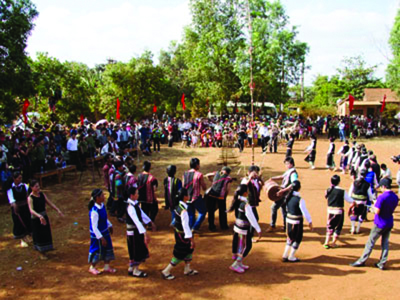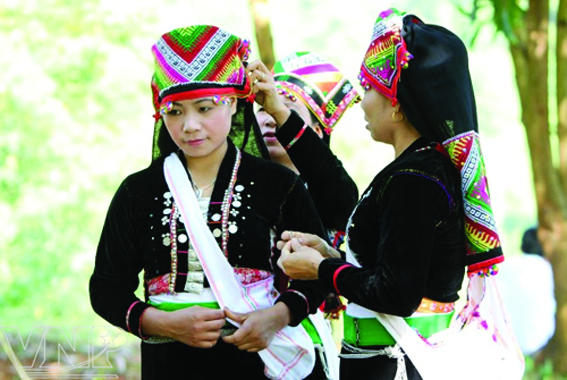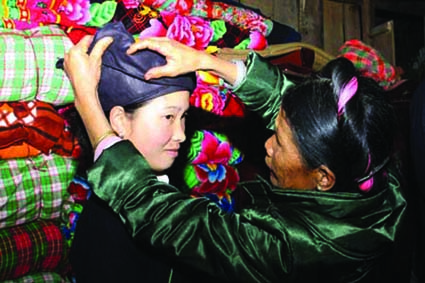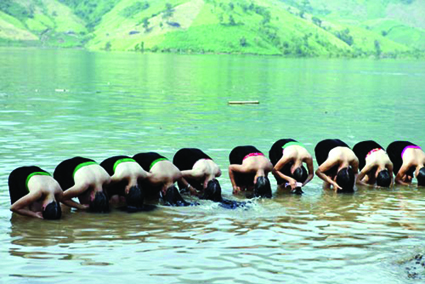Ta Thi Tam
Ethnology Institute
The Chu Ru is a small ethnic group living in Lam Dong, Ninh Thuan and Binh Thuan provinces with a population of around 19,300.
The group lives on wet rice cultivation but also grows maize, potato, cassava, peanut and vegetables. Although using simple farming tools such as plow and harrow, the group is good at irrigation. Each Chu Ru village has a person taking charge of irrigation who is called truong thuy or irrigation head.
Gardening is also popular in Chu Ru community where every family has a small garden for growing pumpkin, vegetables and fruits.
 |
“Husband-catching” festival of Chu Ru people (Lam Dong province) __Photo: Thanh Ha/VNA |
The group also raises cattle, pigs, goats, horses and poultry. Buffaloes are raised not only for plowing but also for religious rituals while horses are used as a form of transport on trips to barter goods with other ethnic groups.
Hunting is not only a source of food supply but a pleasure for Chu Ru men who all own crossbows and arrows. In the old time, villagers used to hold collective hunting. The group is also good at making traps to catch wild animals, which is concurrently a way to protect crops.
Gathering honey, mushrooms, ear fungus, bamboo shoots, yam and wild fruits is an important source to supply daily food for the Chu Ru, particularly in lean times.
The group is also good at pottery even though their techniques are rather rudimentary. Weaving does not develop so the Chu Ru has to barter for clothing with other groups like the Cham, Co Ho and Ha.
A Chu Ru village consists of different family lines and may have people from other ethnic groups. Each village is headed by an elderly man who is selected by villagers. The village head must be a prestigious person who is not only experienced in farming and fighting but also conversant with the history and customs of the village and the group as well. The village head takes charge of guiding villagers in organizing production and life. He is responsible for settling internal and external affairs of the village after consulting old villagers. He is also the spiritual leader of villagers, who hosts all religious rituals of the community. The village head usually comes from the biggest family line in the village.
After the village head, the village sorcerer is the second important person in Chu Ru community who is the spirit of all rituals of the village. The village sorcerer not only conducts community rituals but also is invited to lead family ceremonies.
The third prestigious person in a Chu Ru village is truong thuy who has two assistants. Truong thuy, who is also selected by villagers, must be a fair person conversant with irrigation work. He is responsible for equally regulating water from community irrigation works to every field of villagers. When necessary, he may ask the village head to mobilize villagers to repair irrigation works before a crop.
The Chu Ru lives in an extended family of three or four generations which bears traces of matriarchy as the wife and maternal uncles take the leading role. In a Chu Ru family, daughters have the right to inherit property. An extended family is headed by the oldest man who is the husband of the woman of the older generation. In fact, this man only executes directions of his wife and her brothers who, even living in their sister’s family, have a voice in major family affairs such as property division, sale of land and other assets, and marriage of nieces and nephews.
All members of an extended family share land, cattle and farming tools, working together and jointly enjoying rice, food and other products they have made.
The Chu Ru follows monogamy where women take the initiative in marriage. At the age of 15 or 16, a girl who has chosen her future husband informs her parents of her choice, asking them to invite a matchmaker to visit the boy’s family. The matchmaker and a maternal uncle or the oldest sister of the girl bring offerings to the boy’s to make a marriage proposal. If being accepted, the girl’s family visits the boy’s again on a chosen date for the engagement ceremony in which the matchmaker of the bridal family wears the engagement ring and bracelet for the groom after the two families have a meal together. A Chu Ru wedding may last three or four days, depending on the financial capacity of the bridal family. After the wedding, the bride stays with her husband’s family for two weeks before a ceremony to take the groom to the bride’s home is held.
In Chu Ru society, premarital sex is allowed but adultery is regarded a sin facing severe punishment. Divorce is rare but once it happens, it must be agreed by the village head. Although monogamy is established, polygamy sometimes happens, usually in rich families. A man who wants to marry a second wife must obtain consent of his wife. A widow must mourn her dead husband for one year before she can remarry. And she may marry her dead husband’s brother if both families so agree. The Chu Ru allows marriage between cousins as a way to keep property in big clans.
The Chu Ru believes in polytheism and worships ancestors but does not set up altars at home. When a member dies, the family sets up an altar for him or her in the cemetery and conducts a worship ritual, sacrificing a buffalo or cow. The Chu Ru’s worship ritual dedicated to family ancestors can be held at any time as suitable to economic conditions of each family or clan rather than on fixed dates like in many other ethnic groups.
The group has various farming rituals dedicated to different gods such as Bo Mung (god of dam), Ro Bong (god of ditch) and Khau Doong (god of rice) of which Bo Mung is the most important god. Every area inhabited by Chu Ru people has a separate place to worship this god. Every second lunar month, villagers gather here for a ritual to worship Bo Mung, offering the god a goat. A horse, which must be saddled and dressed ceremonially, is also sacrificed in this ceremony as Bo Mung is believed to be fond of riding horses.
Also in the second lunar month, the Chu Ru conducts another ritual dedicated to Yang Wer, a secular tree in the village which is believed to shelter a powerful deity. Together with food and drinks, the group makes wooden dummies in the shape of elephant, tiger, goat and buffalo heads for offering to Yang Wer. After the offering ritual, villagers carry some of the offerings to a place about 100 meters away from the tree and put them there, which implies serving of food for Yang Wer on his pleasure trip.
The Chu Ru believes all diseases are caused by deities (yang). When a person gets sick, his family invites a sorcerer to conduct an offering ritual to yang to cure the sickness. The group also uses traditional herbs to treat diseases such as smallpox.
The Chu Ru owns a treasure of proverbs, verses, folktales and epics, particularly those telling the history and development of the group and praising matriarchy and the role of women in the society, which are recited by the fire by village patriarchs to young generations from one night to another.-





